Exercises (2269)
Shoulder thrust with restriction
Fighting and roughhousing games
Partner work
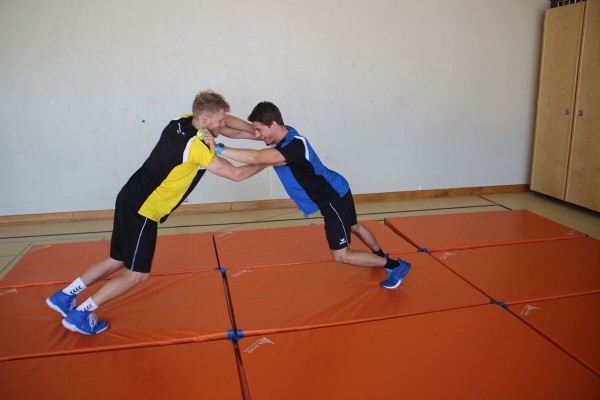
Two participants line up in the centre of a mat/lawn area and try to push each other off a mat/lawn area. The participants each hold a tennis ball in their hands. The tennis balls restrict the participants in their fighting behaviour, which should prevent scratches and/or abrasions. The first person to put a foot next to the court loses.
9 soft mats (small) ► indoor version
4 tennis balls
4 marking cones/caps ► indoor and outdoor version
Indoor post set-up:
form a rectangular mat field using soft mats.
Indoor/outdoor post set-up:
define a rectangular field using caps.
Suspended push-off
Fighting and roughhousing games
Partner work

Two participants sit opposite each other in a suspended position (legs and upper body raised off the floor, only the buttocks touch the floor, arms possibly crossed in front of the body). With the support of their legs, the participants try to unbalance their opponent. As soon as a participant touches the floor with their back, hands or feet, they lose. The competition can be performed with or without permanent contact between the legs/feet.
Caution:
Despite any fatigue, a hollow back position must be avoided (actively tense the torso).
No material required
Scorelauf
Orienteering
Single run or groups of 2/3
Send participants/groups onto the course in staggered formation (note the distance to the first starter/starting group on the run card)
In the terrain, the sports director distributes the controls in advance, which the participants run to individually or in small groups during the scorelace. For this purpose, the participants receive a control overview and a running map. Each control gives a certain number of points. Logically, the easier, obvious controls score the fewest points. The scorelace can be run both as an exercise and as a competition. It is worth staggering both variants so that each participant/group has to work independently and cannot simply follow a runner/group in front (note the time intervals/difference to the first start time on the run card for the evaluation). The control overview with the running map can either be handed out together with the start signal or distributed to the runners/groups a certain time before the start. The participants collect as many points as possible in the time provided. Points will be deducted if they are late at the finish (e.g. 5 points deducted for every minute started after the agreed finish time).
Variant:
Prepare the post transfer point: The participants do not receive a map on which the controls are already marked, but must mark the controls themselves at a control transfer point (e.g. using coordinates, azimuth or measuring point method). The control sheets remain at the start even after the transfer. Before the participants set off on the course, the sports director checks the marked controls.
Orienteering controls (to be unplugged)
1 stopwatch
Participant/group:
1 orienteering map with control overview incl. designation and scoring (prepared in advance by the sports director)
1 running map form 30.063
1 bussole
Variation of the exercise:
Participant/group:
1 control transfer sheet
1 map scale
1 pencil and eraser
Seasickness relay
Forms of play / exercises
Group work
4-5 participants per group
The runners run to the reversal point equipped with a Smolball stick, floorball/intercrosse stick or Nordic walking stick. At the turning point, the stick/stick is held vertically to the ground. Then make 15 rotations (as quickly as possible) around the stick/stick. During the rotations, both hands hold the stick/stick blade and the head is placed on the upper hand. The group counts the number of turns out loud and, after the last turn, calls the runner back, who probably tries to reach the group while staggering, in order to hand the stick/stick to the next runner and send them on their way.
Per group:
1 Nordic walking, intercrosse or floorball stick
1 Smolball stick
Rope/rope pulling ► rope pulling
Power
Partner work
1 trainee & 1 helper ► Note change of position
(= double the time required; for lesson planner see Organisation Kraft: Info button Execution)


► Exercise only suitable in the gym!
Trainee: Pulls their partner towards them by pulling on the rope/rope. As soon as both participants are in the same position, the trainee distances themselves until the rope/rope is stretched to its full length so that they can pull their partner towards them again.
Partner: Stands in a squatting position (stable torso; stomach tensed) on the carpet remnants and holds on to the end of the rope/rope.
Attention:
Both participants ensure a straight back.
Lighten:
Lighter partner.
Harden:
Heavier partner (partner with additional weight).
1 rope/rope
2 carpet remnants
1 weight waistcoat ► to make the exercise more difficult (additional weight)
Skipping rope
Light-Contact
Partner work
Skipping in place, alternating between bringing one leg to the ground and lifting the other leg up to navel height with the knee (skipping).
2 skipping ropes (one rope per participant)
Rope skipping / ball kicking
Light-Contact
Partner work
The two positions are changed at each round.
Position 1:
Skipping rope by jumping on the spot with both legs.
Position 2:
Holding a medicine ball with both hands in front of the chest in a stepping position (staggered stance). Push the ball to the ground with one arm (side can be varied) and catch it again with both hands. After each kick, shift position slightly without crossing your legs and then kick the ball towards the floor again.
1 skipping rope
1 medicine ball
Rope pulling
Fighting and roughhousing games
Partner work
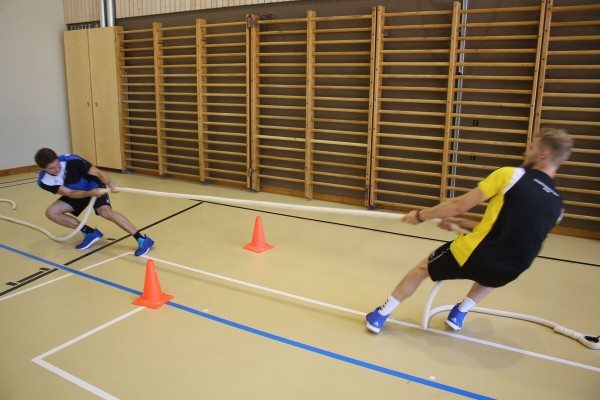
Two participants stretch a rope between them (holding the rope in their hands) and stand facing each other at a distance of approx. 3-4 metres. The participants try to pull their opponent over the centre line (or the opponent/the centre of the rope over a certain line). Whoever is pulled over the line first loses.
1 rope
2 marking cones/caps (optional) ►Field marking
Post set-up:
Mark the defined baseline (for the centre of the rope) using cones.
Lateral forearm support (left) ► lateral pillar bridge / side plank / side bridge
Power
Individual work
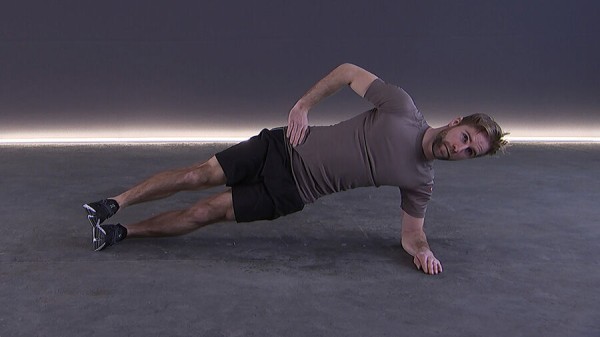
Lateral support on the (left) forearm (possibly on a wall for the correct straight position), free (right) arm supported on the hip or held upright, hold the position.
Attention:
Head, torso, hips and knees form a line (pelvis does not tilt backwards or forwards), keep the shoulder above the elbow.
Lighten:
Knees on the floor.
Harden:
Additional weight (on the hips); unstable support (possible for both the arm and the legs).
1 weight vest/weight disc/sandbag ► make the exercise more difficult (additional weight)
1 ball/1-2 balance cushions/1 balance board ► make the exercise more difficult (unstable surface)
Lateral forearm support (left) ► lateral pillar bridge / side plank / side bridge
Power
Individual work

Side support with the left forearm on the balance board. Raise your upper leg slightly off the floor (in extension of your body) and bend your lower leg on the floor (kneeling, foot pointing backwards). Hold the position you have assumed.
Attention:
Head, torso, hips and knees practically form a line (pelvis does not tilt backwards or forwards), keep shoulder above elbow.
Lighten:
Lateral forearm support without balance board; support upper leg extended on the floor as an extension of the body.
Harden:
Both legs stretched out in extension of the body (outer instep of the lower foot supports the overlapping legs).
Variant:
Lift and lower the pelvis.
1 balance board incl. roller
Lateral forearm support (right) ► lateral pillar bridge / side plank / side bridge
Power
Individual work

Side support on the (right) forearm (possibly on a wall for the correct straight position), free (left) arm supported on the hip or held upright, hold the position.
Attention:
Head, torso, hips and knees form a line (pelvis does not tilt backwards or forwards), keep the shoulder above the elbow.
Lighten:
Knees on the floor.
Harden:
Additional weight (on the hips); unstable support (possible for both the arm and the legs).
1 weight vest/weight disc/sandbag ► make the exercise more difficult (additional weight)
1 ball/1-2 balance cushions/1 balance board ► make the exercise more difficult (unstable surface)
Lateral forearm support (right) ► lateral pillar bridge / side plank / side bridge
Power
Individual work

Side support with the right forearm on the balance board. Lift the top leg slightly off the floor (in extension of the body) and bend the bottom leg on the floor (kneeling, foot pointing backwards). Hold the position you have assumed.
Attention:
Head, torso, hips and knees practically form a line (pelvis does not tilt backwards or forwards), keep shoulder above elbow.
Lighten:
Lateral forearm support without balance board; support upper leg extended on the floor as an extension of the body.
Harden:
Both legs stretched out in extension of the body (outer instep of the lower foot supports the overlapping legs).
Variant:
Lift and lower the pelvis.
1 balance board incl. roller
Lateral forearm support / lateral support (left) ► side plank / lateral pillar bridge / side bridge
Power
Individual work



Progression I:
Side support on the left forearm with the legs in the foot supports (crossed over, top leg in front). Support the upper right arm on the floor in front of the body, lift the pelvis off the floor and hold the position. To increase the intensity, support the free arm on the hip or extend it vertically upwards.
Progression II:
Analogue to Progression I, but only supported on one hand. Increase the intensity according to progression I.
Attention:
Keep body tension, do not let hips sag, back straight, forearm under shoulder (for both progressions).
Harden:
The further away the head is from the attachment point, the more challenging the exercise becomes.
Variant I:
Lift and lower the pelvis.
Variant II:
Alternately bring the upper arm under the body and extend it upwards, accompanying the movement with the head.
1 sling trainer
Lateral forearm support / lateral support (right) ► side plank / lateral pillar bridge / side bridge
Power
Individual work



Progression I:
Side support on the right forearm with the legs in the foot supports (crossed over, top leg in front). Support the upper left arm on the floor in front of the body, lift the pelvis off the floor and hold the position. To increase the intensity, support the free arm on the hip or extend it vertically upwards.
Progression II:
Analogue to Progression I, but only supported on one hand. Increase the intensity according to progression I.
Attention:
Keep body tension, do not let hips sag, back straight, forearm under shoulder (for both progressions).
Harden:
The further away the head is from the attachment point, the more challenging the exercise becomes.
Variant I:
Lift and lower the pelvis.
Variant II:
Alternately bring the upper arm under the body and extend it upwards, accompanying the movement with the head.
1 sling trainer
Lateral forearm support with raised leg (left) ► lateral pillar bridge / side plank / side bridge
Power
Individual work

Side support on the left forearm (possibly on a wall for the correct straight position). Raise the top leg, extend the free arm in a high position (starfish) or support it on the hip and hold the position.
Attention:
Head, torso, hips and knees form a line (pelvis does not tilt backwards or forwards), keep the shoulder above the elbow.
Lighten:
Knee on the floor; spread the upper leg less.
Harden:
Additional weight (on the hip, on the upper leg for additional training of the leg muscles); unstable base (possible for both supporting arm and supporting leg).
1 weight cuff/weight vest/weight disc/dumbbell/sandbag ► make the exercise more difficult (additional weight)
1 ball/1-2 balance cushions/1 balance board ► make the exercise more difficult (unstable surface)
Lateral forearm support with raised leg (right) ► lateral pillar bridge / side plank / side bridge
Power
Individual work

Side support on the right forearm (possibly on a wall for the correct straight position). Raise the top leg and stretch the free arm upwards (starfish) or support it on the hip and hold the position.
Attention:
Head, torso, hips and knees form a line (pelvis does not tilt backwards or forwards), keep the shoulder above the elbow.
Lighten:
Knee on the floor; spread the upper leg less.
Harden:
Additional weight (on the hip, on the upper leg for additional training of the leg muscles); unstable base (possible for both supporting arm and supporting leg).
1 weight cuff/weight vest/weight disc/dumbbell/sandbag ► make the exercise more difficult (additional weight)
1 ball/1-2 balance cushions/1 balance board ► make the exercise more difficult (unstable surface)
Alternating lateral tilting of the upper body while standing
Power
Individual work


Stand upright with your hips wide apart, hold the object high above your head and then tilt your upper body alternately to the left and right side.
Attention:
Do not lean your upper body forwards or backwards, no hollow back (tense your torso).
Lighten:
No additional weight; lean your upper body less to the side.
Harden:
Additional weight (e.g. place stones in the helmet or a combat backpack)
1 helmet/(medicine) ball
1 combat rucksack/tyre (PUCH)/3-4 stones ► Make the exercise more difficult (additional weight)
Alternating lateral tilting of the upper body while standing ► side bend
Power
Individual work


Stand upright, shoulder-width apart with your feet in the loops. The gymnastics pole is held on the shoulders behind the head and the upper body is tilted alternately to the left and right side.
Attention:
Do not lean your upper body forwards or backwards, no hollow back (tense torso).
Lighten:
Select less strong elastic bands; roll up the elastic bands less.
Harden:
Select stronger elastic bands; roll up the elastic bands more.
1 gymnastic bar with elasticated straps
Lateral tilting of the upper body in forearm support ► pillar bridge / plank rolls
Power
Individual work
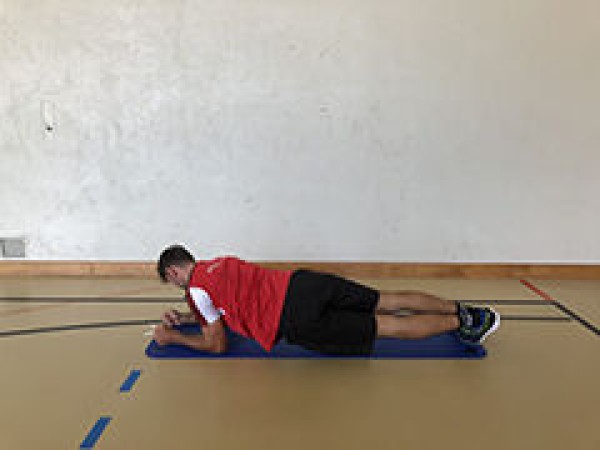
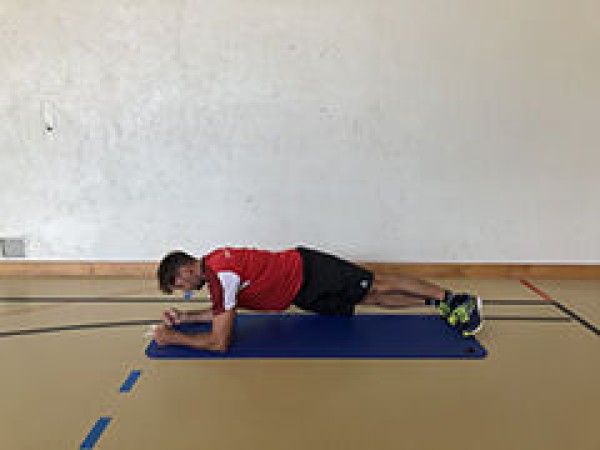

In the forearm support (the stretched legs and upper body practically form a line, the legs are supported on the tips of the toes and the upper body on the forearms, the forearms lie flat on the floor parallel to each other, the upper arms are vertical) tilt the upper body to the left or right side and return to the starting position.
Attention:
Head, torso, hips and knees practically form a line (do not stretch your buttocks upwards or allow them to sag, tense your stomach).
Lighten:
Knees on the floor.
Harden:
A stable base for the legs and/or arms is possible.
1-2 balls/balance cushions/balance boards ► Make the exercise more difficult (unstable surface)
Lateral raising of the arms in prone position ► prone T hold
Power
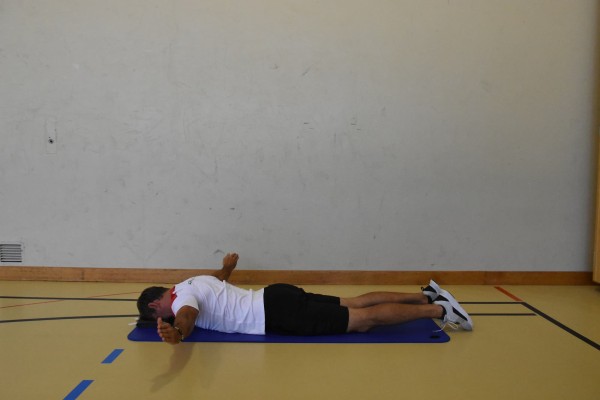
Lie on your stomach with your forehead resting on a folded sheet, feet shoulder-width apart, arms pointing to either side (T-position). From this position, pull the shoulder blades together and raise the arms until the elbows are at shoulder height and the arms are parallel to the floor (palms facing forward or downward). Keep your arms straight and hold the position.
Attention:
Only the arms should be raised, nothing else - aim to isolate the upper back.
Harden:
Hold additional weight in your hands or on your arms.
2 weight cuffs/2 weight balls/dumbbells ► Make the exercise more difficult (additional weight)
Lateral raising of the arms in prone position ► prone T raise hold / prone lateral raise hold
Power
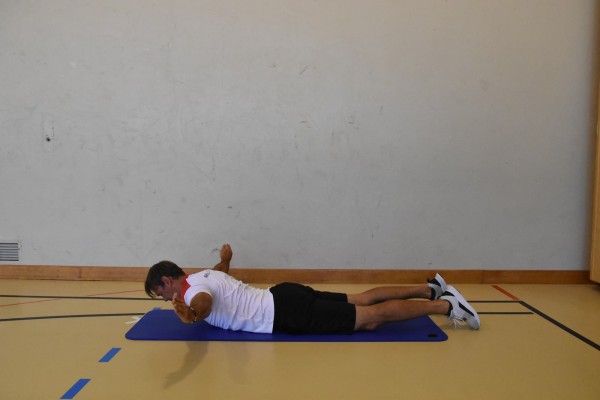
Lie on your stomach with your upper body slightly raised, feet shoulder-width apart, arms pointing to either side (T-position). From this position, pull your shoulder blades together and raise your arms until your elbows are at shoulder height and your arms are parallel to the floor (palms facing forward or downward). Keep your arms straight and hold the position.
Attention:
Only the arms should be raised, nothing else - aim to isolate the upper back.
Harden:
Hold additional weight in your hands or on your arms.
2 weight cuffs/2 weight balls/dumbbells ► Make the exercise more difficult (additional weight)
Lateral raising of the arms in prone position ► prone W hold
Power
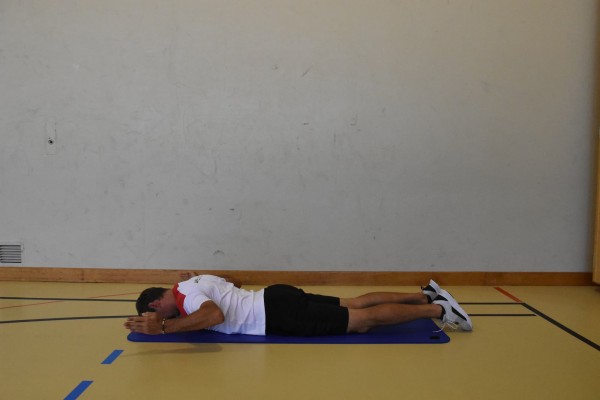
Lie on your stomach with your forehead resting on a folded sheet, feet shoulder-width apart, arms bent, elbows close to your body, arms pointing diagonally forwards to the respective side (W position). From this position, pull the shoulder blades together and raise the arms until the elbows are at shoulder height and the arms are parallel to the floor (palms facing inwards at an angle). Keep your arms straight and hold the position.
Attention:
Only the arms should be raised, nothing else - aim to isolate the upper back.
Harden:
Hold additional weight in your hands or on your arms.
2 weight cuffs/2 weight balls/dumbbells ► Make the exercise more difficult (additional weight)
Lateral raising of the arms in prone position ► prone raise hold
Power
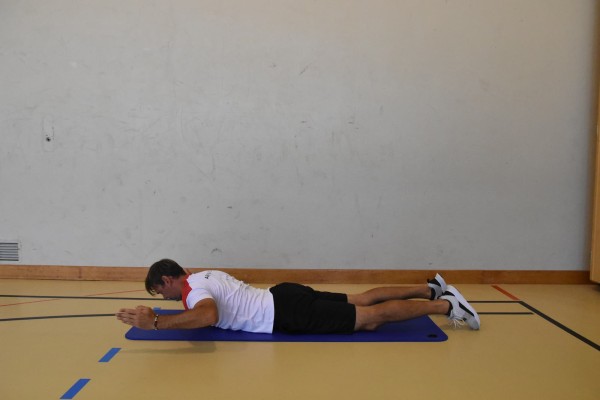
Lie on your stomach with your upper body slightly raised, feet shoulder-width apart, arms bent, elbows close to your body, arms pointing diagonally forwards to each side (W position). From this position, pull the shoulder blades together and raise the arms until the elbows are at shoulder height and the arms are parallel to the floor (palms facing inwards at an angle). Hold the position.
Attention:
Only the arms should be raised, nothing else - aim to isolate the upper back.
Harden:
Hold additional weight in your hands or on your arms.
2 weight cuffs/2 weight balls/dumbbells ► Make the exercise more difficult (additional weight)
Lateral raising and lowering of the arms while standing ► lateral arm raise
Power
Individual work


Stand upright with your feet shoulder-width apart, arms outstretched to the side (shoulder height), raise and lower your arms or perform circular movements with your arms (vary the range).
Attention:
Do not circle your arms below hip height or above head height (tension).
Lighten:
Just hold the position.
Harden:
Hold additional weight on your arms or in your hands.
2 weight cuffs/weight balls/dumbbells ► Make the exercise more difficult (additional weight)
Lateral raising and lowering of the arms while standing ► lateral raise
Power
Individual work

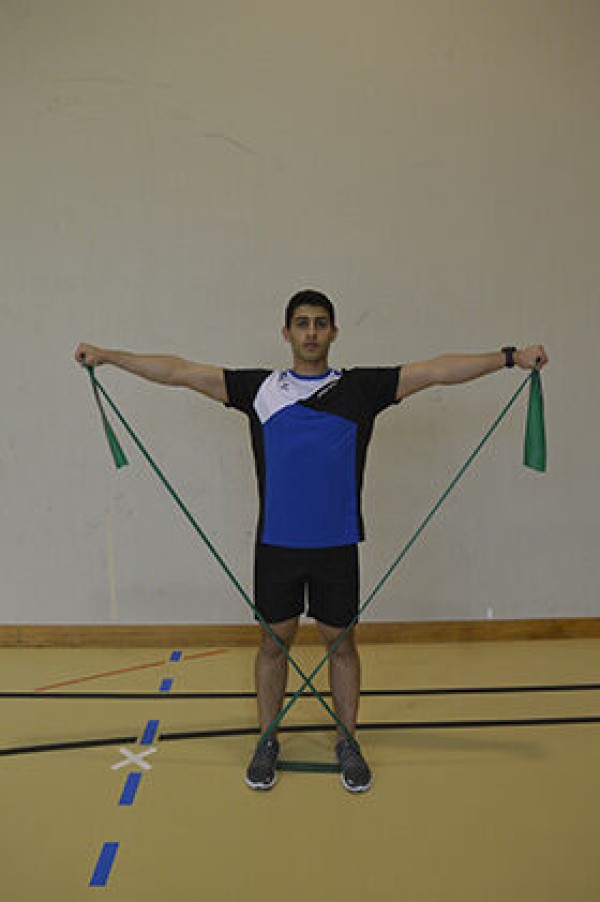
Stand shoulder-width apart in the centre of the elastic band, with your upper body tilted far forward and your arms hanging down at the side of your body (shoulders set) Cross the elastic band and grasp one end with each hand, raise your arms sideways to approximately shoulder height and lower them back to the starting position.
Attention:
The upper body remains stable.
Lighten:
Choose an elastic band with less resistance.
Harden:
Choose an elastic band with greater resistance.
1 elasticated rubber band